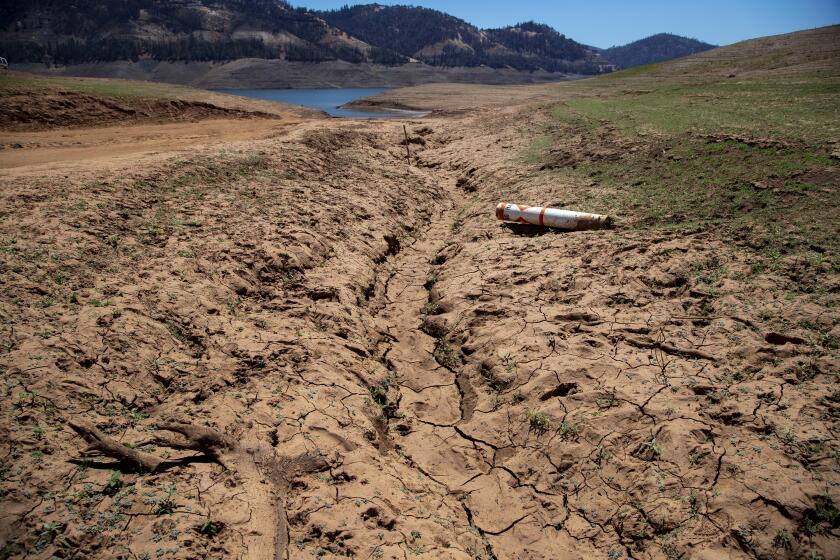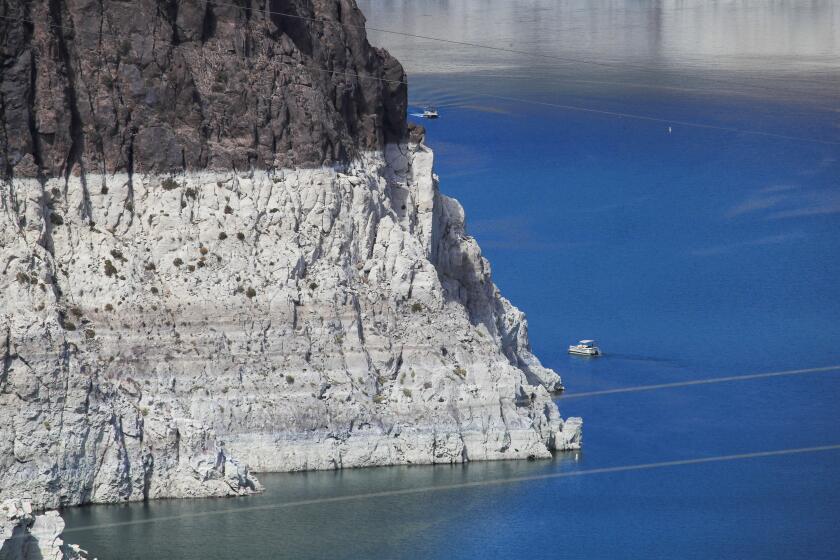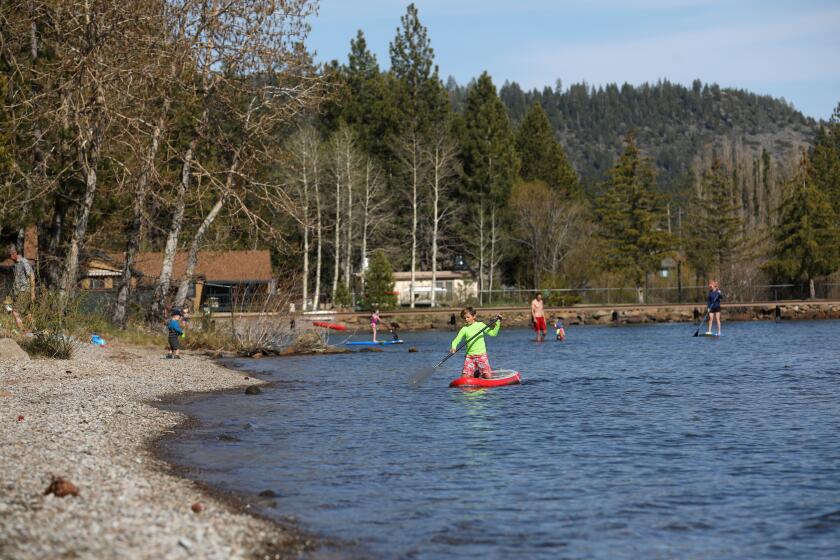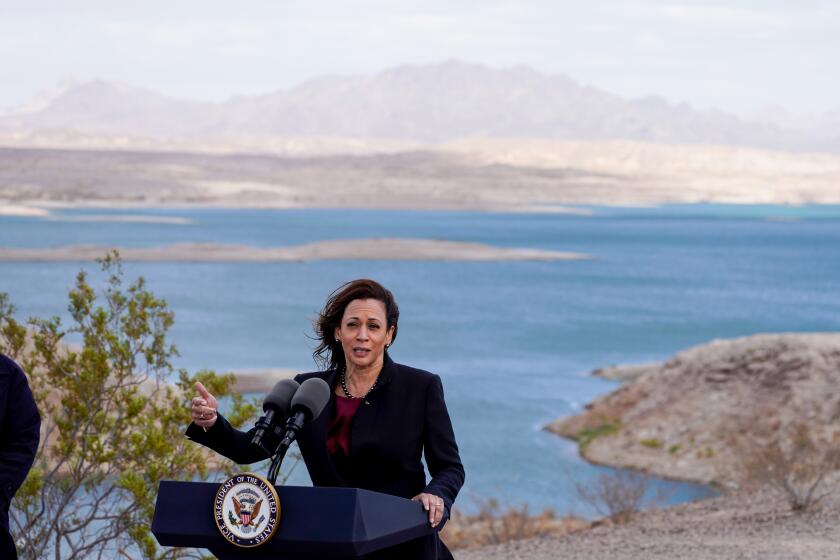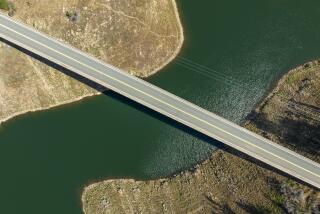Newsom declares statewide drought emergency, urges California to conserve water
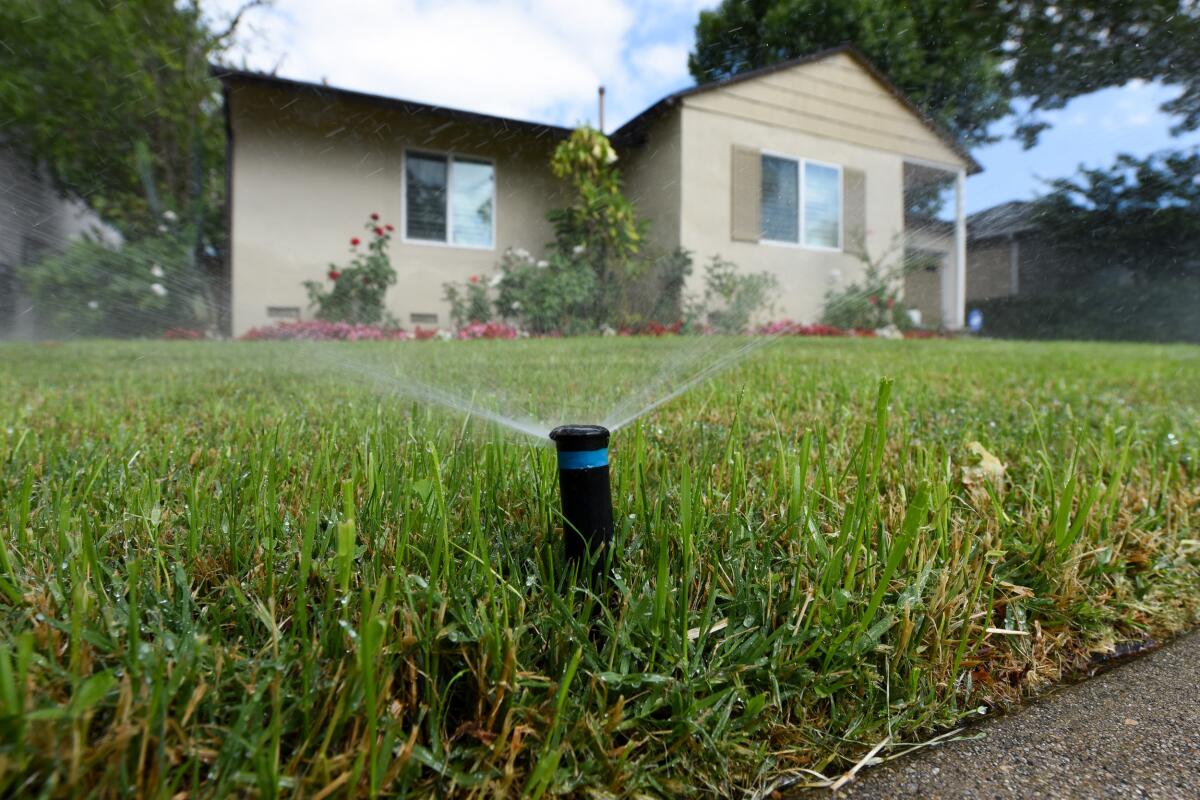
Gov. Gavin Newsom declared a statewide drought emergency on Tuesday, appealing to all Californians to do more to conserve water in the face of one of the state’s most severe droughts on record.
“As the western U.S. faces a potential third year of drought, it’s critical that Californians across the state redouble our efforts to save water in every way possible,” Newsom said.
While most of California’s 58 counties have been in a state of drought emergency since July, Newsom’s proclamation added the last eight remaining counties, and further bolstered his call for everyone to voluntarily reduce water use by 15%. The proclamation notes that the State Water Resources Control Board may adopt emergency regulations to prohibit wasting water, such as hosing down sidewalks or driveways, allowing drinking water to flood gutters or streets, or washing a car without a shut-off nozzle.
The declaration came as state water officials announced that Californians had cut their water usage by 5% in August, a modest improvement over July, when water use decreased by 1.8%
The proclamation orders local water suppliers to implement their water shortage contingency plans at “a level appropriate to local conditions that takes into account the possibility of a third consecutive dry year.”
The eight counties added to the emergency declaration are Imperial, Los Angeles, Orange, Riverside, San Bernardino, San Diego, San Francisco and Ventura.
The monthly water conservation figures, which were released during a meeting of the State Water Resources Control Board, showed parts of the state already meeting or approaching the governor’s call for reducing water use.
Water use decreased 18.3% in August in the North Coast region and 9.9% in the San Francisco Bay Area.
In the South Coast region of Southern California, which is home to more than half the state’s population, people used 3.1% less water in August than they did in the same month in 2020. While still far from Newsom’s target, that was significantly better than in July, when the region’s water use was down a minuscule 0.1%.
“It is encouraging and heartening to see an over-doubling of the conservation effort from July to August, really demonstrating that it does take time for … the message to spread, and for, really, the response to be seen,” said Joaquin Esquivel, chair of the state water board. “We’re seeing good signs, but we need to continue to ensure we’re conserving.”
A series of storms are forecast to bring rain and high-elevation snow to northern and central parts of California in late October. But those storms alone won’t be nearly enough to pull the state out of drought.
The state Department of Water Resources has said that because the past year has been extremely hot and dry, an estimated 140% of average statewide precipitation would be needed in the coming year to achieve average statewide runoff. The agency said in a report that this reflects the “moisture deficit” across the state.
The Metropolitan Water District of Southern California responded to the governor’s statewide drought declaration calling for all communities to help conserve limited water resources.
Adel Hagekhalil, the MWD’s general manager, said people in Southern California have done a great job using water more efficiently in recent years.
“Metropolitan has worked alongside them to adjust our operations and increase our calls for conservation to ensure the region has water to get through this drought,” Hagekhalil said in a statement. “But given the increasing severity of conditions, we all need to step up and immediately cut back our water use even more.”
He said the MWD board of directors will consider next month whether to urge member water agencies across Southern California “to implement mandatory conservation in their communities, as outlined in their water shortage contingency plans.”
Hagekhalil said that these community-specific plans will help promote conservation, and that Metropolitan plans to expand its programs offering rebates that encourage customers to make water-saving changes.
The average accumulation of rain and snowfall across the state totaled only 11.87 inches during the 2021 water year, which ran Oct. 1, 2020, through Sept. 30.
The past year ranks among the most severe droughts in more than a century of records in California.
Based on statewide precipitation totals, the water year that ended Sept. 30 was the second-driest on record, surpassed only by 1924. State officials say the past two water years have been the driest on record for a two-year period, surpassing the drought of 1976-77.
Scientific research has shown that the heating of the planet with the burning of fossil fuels is making droughts more intense in the West and reducing the flows of rivers beyond the decreases they would have seen without global warming.
Major reservoirs in Northern California, from Shasta Lake to Folsom Lake, have dropped to extremely low levels. The federal government has declared a shortage on the Colorado River for the first time, forcing substantial cuts in water supplies for Arizona, Nevada and Mexico.
Because California faces the potential for another dry winter, Esquivel said, it will be especially important for people to do more to conserve.
Newsom declared a statewide drought emergency and is asking all Californians to conserve water. Here are some ideas for how to do that.
For part of the last drought between 2012 and 2016, then-Gov. Jerry Brown ordered a mandatory 25% reduction in urban water use. Many Californians responded and took steps such as replacing lawns with drought-tolerant plants. Those changes in water habits have had a lasting effect in reducing water use.
Esquivel said conservation will be vital “for the long term as we battle climate change.” He and others at the water board will be watching the conservation figures going into the winter months, a time when less water is used due to lower temperatures and less outdoor watering.
“Certainly 5% isn’t 15. And we’re really needing to see a double-down on conservation,” Esquivel said. He said state water regulators will continue to “work with communities to see that conservation way of life ethic really embraced.”
Some boat ramps and docks are hundreds of feet from the water line, said Geoffrey Schladow, director of the UC Davis Tahoe Environmental Research Center.
Water suppliers in different parts of the state have been taking different approaches to encouraging conservation based on their local circumstances. San Jose Water Company, for instance, is taking steps to implement a mandatory water conservation plan and is seeking approval from state regulators to begin charging customers drought surcharges if they don’t meet the 15% conservation requirement. The water company serves about 1 million people in much of San Jose and other surrounding communities.
“Because we have not hit 15%, we’re now taking the next steps,” spokesperson Liann Walborsky said in a phone interview. “It’s critical that people conserve. I think some people are taking this seriously, some people aren’t. But this is severe.”
Officials from several local water districts spoke during the meeting, discussing the steps they are taking to encourage people to use less. For some agencies, the efforts have included relaunching drought websites, airing advertisements to promote conservation and dispatching more employees on patrol to spot water wasting.
Piret Harmon, general manager of Scotts Valley Water District in Santa Cruz County, said customers in the area reduced water use by about 20% during the last drought and have sustained that reduction, an important step for an area that depends entirely on local water supplies.
“Our community has continued to save, so for us the 15% ask this time is a little different. I very much appreciate the spirit of that, calling on customers to save more,” Harmon said. “But it does confuse our customers a little bit when they come to us and say, ‘What does it mean? I’ve done everything. How much more can you ask me to do?’”
Harmon said all customers in the district are now on meters that allow them to see their individual water use in 15-minute increments, which has helped them spot leaks and water waste. The district has also tried to get more people behind saving water, she said, by hosting a water-saving challenge with a raffle and awards.
Some people in the area are already going to great lengths, she said, including collecting water while showering and using it to water plants.
“Every individual is unique, and every region is unique,” Harmon told the water board’s members.
Vice President Kamala Harris visits Nevada to stump for President Biden’s infrastructure and climate agenda.
Esquivel said he appreciates that point.
“Especially if folks have already invested and are conserving as much as you can on your household level, then good,” Esquivel said. “It’s really about the message writ large. And it’s especially that 15% number, which isn’t meant to translate specifically to, you know, what each district should be aiming for, or even each household. But a way to set a metric and a target to say, ‘This is what we’re going to try to reach for as the state to really boost up conservation.’”
To assess conservation efforts, the state water board is tracking monthly water use by more than 400 urban water suppliers throughout California.
Some of those who spoke at the meeting stressed that saving water also can help to save a lot of energy and reduce greenhouse gas emissions.
“We know in California that water and energy are inextricably linked,” said Heather Cooley, director of research for the Pacific Institute. “By implementing comprehensive urban water efficiency, we can significantly reduce our future water use and the associated energy use and greenhouse gas emissions.”
Cooley recently co-authored a report with other researchers from the Pacific Institute and Next 10 about the water-energy nexus in California. They found that water conservation and efficiency efforts in urban areas could significantly reduce water-related electricity use and natural gas use between now and 2035.
The researchers noted that California’s water system, from its pumps to water treatment plants, is responsible for about 20% of total statewide electricity use. They said improving water-use efficiency in urban areas offers the greatest potential for reducing water-related energy use and emissions that contribute to global warming.
“Agricultural water use is far greater than that of California’s urban sector, but the urban water is nine times more energy intensive and produces nine times more greenhouse gas emissions,” Cooley said during a recent webinar. “We have made significant improvements in water efficiency, in urban efficiency especially, but far more can be done. Urban conservation and efficiency can help us to meet our water goals as well as our energy and climate goals.”
More to Read
Sign up for Essential California
The most important California stories and recommendations in your inbox every morning.
You may occasionally receive promotional content from the Los Angeles Times.
